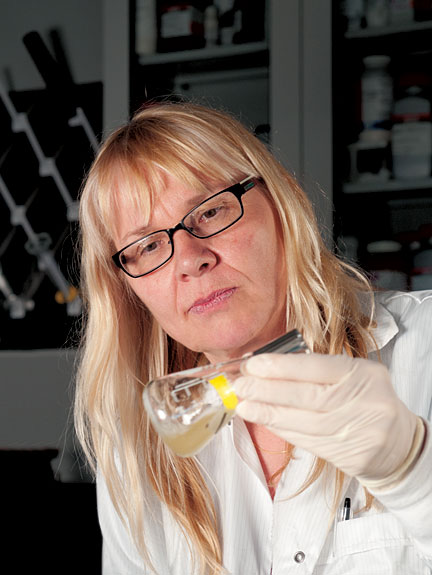Few materials have been as kind to civilization as wood.
It made possible some of our most revolutionary technologies: the spear, fire, the wheel, the house, the ship. Hunting, cooking, shelter, transportation, all got big assists because wood was abundant, changeable, sturdy, and packed with energy.
WSU researchers are now trying to wring a whole new suite of uses from wood, including jet fuel and alternatives to other petroleum-based products. They have millions of tons of raw material at their disposal in logging residues across the Northwest. Leading the Northwest Advanced Renewables Alliance, a consortium of universities, government labs, and industry, they have $40 million in federal funding.
If things go right, they’ll lead the way to a new source of liquid fuel that can be domestically produced without displacing food production or contributing to global warming. All from sticks that are currently left on the ground or burned in giant slash piles.
Now come the hard parts. Wood, for all its elegance and obvious utility, is very complicated stuff. It’s made of three “very different polymeric materials”—cellulose, hemicellulose, and lignin, explains Mike Wolcott, a materials engineer and NARA co-project director, and they interact at a small, hard-to-study nano-scale.
“The real difficulty in understanding these things is these systems are kind of a black box,” he says.
Which brings us to what scientists call “biomass recalcitrance.” Science and industry want to break wood apart so enzymes can be let loose on the wood’s cellulose and hemicellulose. The enzymes will detangle their long molecules, producing sugars than can be fermented to make fuel.
“We’re just after the sugar,” says Wolcott.
Wood’s glue-like lignin prevents this, a testament to the material’s time-honored resistance to rot. But if scientists can find a way to get around lignin’s resistance, the energy world will beat a path to their door.
Birgitte Ahring, a WSU Tri-Cities microbiologist and director of the Center for Bioproducts and Bioenergy, has a promising “wet explosion” process that breaks down wood with steam, a sudden release of pressure, and oxidation that lets sugars be released by enzymes. She and colleagues recently reported getting the highest sugar yield yet from loblolly pine, a soft wood with some of the challenges of the Northwest’s Douglas fir.
“Biomass is like beautiful steak,” she says, “but it has cellophane on top of it. So now we remove the cellophane so you’re into the juicy steak.”
But finding a better way to get energy from wood will fix only part of the problem. Fuel, particularly the aviation biofuel craved by commercial carriers and the military, garners lots of attention, but in commercial terms, it’s not the best bang for the buck.
Think about the economics at the pump: An entire gallon can be bought for a few dollars, like milk. But if you developed a medicine from lignin, a single pill could earn as much, as could scores of chemicals and other products that might be derived from lignin.
“I think we have a bullet, a magic bullet,” says Ahring. “We just have to open the box of lignin products with oxidation. We haven’t done that. We have demonstrated that we can make the sugars that people want to make fuels. The next would be to demonstrate we can also create the building blocks for making high-value chemicals from lignin.”
“People have been screwing around with lignin forever,” says Wolcott, “and the old joke is you can make anything you want out of lignin except money.”
A 2007 study by the Pacific Northwest National Laboratory said lignin’s complex nature makes it hard to identify products to make from it. Still, the authors found more than 50. If it were used to make carbon fiber, they said, just 10 percent of the nation’s potential lignin supply could displace half the steel in America’s automobiles.
But even if lignin’s economic and technological hurdles are overcome, the NARA group still faces the challenge of getting its ideas executed in the marketplace. It’s why a NARA team is already working to identify Northwest communities that might be part of a biofuels economy.
“Really what this project is about is moving an industry,” says Wolcott. “How do you get an industry launched? And what is the role for a public-private partnership like this that could help launch a new industry like this?”


